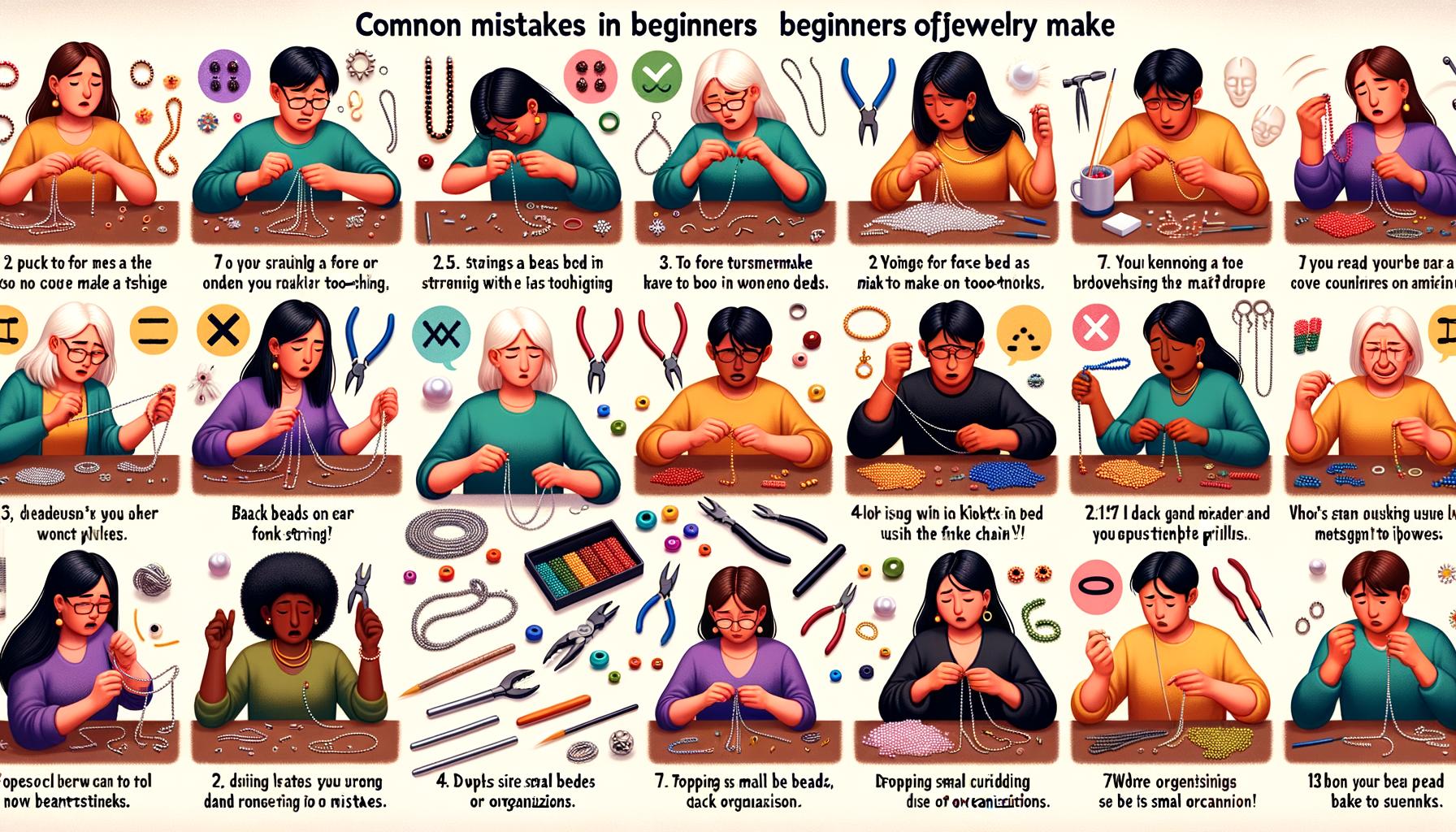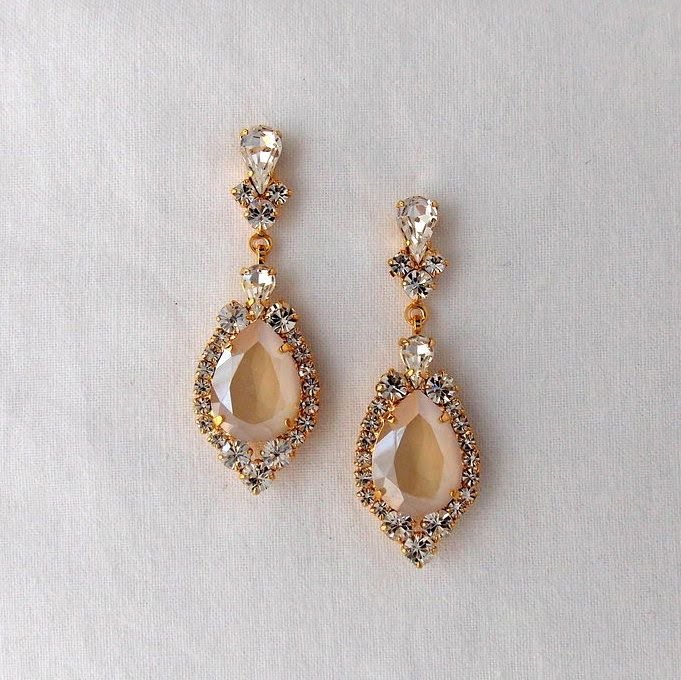Jewelry making for beginners: avoiding common mistakes can be an exciting and creative outlet. Whether you’re looking to start a new hobby, create personalized gifts, or even launch a small business, crafting your own jewelry offers endless possibilities for self-expression. There’s something incredibly fulfilling about transforming basic materials like beads, wires, and clasps into beautiful, wearable pieces of art.
However, despite the excitement and creativity involved in jewelry making, it’s essential to recognize that beginners often face a range of common mistakes. These errors can lead to frustration and wasted materials but are entirely avoidable with the right guidance. By understanding these pitfalls early on, you can ensure that your journey into jewelry making remains enjoyable and successful.
This article is designed to help novices navigate the initial hurdles of their jewelry-making adventure. From selecting the right materials to mastering essential techniques, we’ll cover all aspects critical for beginners. With practical tips and expert advice, you’ll be well-equipped to create stunning pieces while avoiding the common mistakes that can trip up newcomers to this delightful craft.
Understanding the Basics of Jewelry Making
Getting started in jewelry making for beginners: avoiding common mistakes involves familiarizing yourself with specific tools and materials that make the process smoother and more enjoyable. Essential tools include round-nose pliers for shaping loops, flat-nose pliers for holding components, and wire cutters to trim excess wire.
You will also need a variety of wires in different gauges to suit your projects as well as beads, clasps, and crimp tubes. High-quality tools create a noticeable difference in your craftsmanship by providing better precision and comfort.
Starting with simple projects is crucial for building confidence and fundamental skills in jewelry making. Beginners are often tempted to dive into complex designs right away, but this can lead to frustration. Simple projects such as making bead bracelets or basic wire earrings allow you to practice important techniques like stringing beads or creating wire loops without becoming overwhelmed. These foundational exercises will help you gain proficiency in handling tools and materials.
Another key aspect is setting up an organized workspace conducive to creativity while preventing common mishaps. A clutter-free area with good lighting enhances concentration and visibility when working with small components. Investing in storage solutions like bead organizers or tool racks can keep your supplies neat and easily accessible. An efficient workspace not only makes the process more enjoyable but also helps avoid errors caused by misplaced items or insufficient space.
Choosing the Right Materials
When embarking on your jewelry making journey, selecting the right materials is a critical step that can greatly impact the quality and durability of your creations. One common pitfall to watch out for is purchasing low-quality beads, wires, or findings.
These subpar materials can lead to frustration as they may break easily, tarnish quickly, or simply not look as polished in the final product. As a beginner in jewelry making for beginners: avoiding common mistakes involves learning how to discern between high-quality and low-quality materials.
Identifying High-Quality Materials
High-quality beads typically have uniform shapes and sizes, smooth surfaces, and vibrant colors that do not fade over time. They will also feel more substantial when held.
To identify high-quality metal components like wires or clasps, look for descriptions indicating materials such as sterling silver, gold-filled, or stainless steel rather than “plated” metals which can wear off with use. Another tip is to purchase from reputable suppliers who specialize in jewelry making supplies; these vendors usually have better quality control and customer reviews that can offer guidance.
Beginner-Friendly Material Suggestions
For those just starting out, some materials are easier to work with than others. Soft wire such as copper is very forgiving and easy to bend but strong enough to hold its shape-ideal for practicing wire wrapping techniques.
Beads made from glass or acrylic are also great options due to their wide availability and affordability; plus they come in numerous colors and shapes allowing you plenty of room for creativity without breaking the bank. When choosing stringing materials, stretchy cords or basic beading threads are beginner-friendly options that provide flexibility and ease of use while still offering durability.
Avoiding Common Pitfalls
One common mistake beginners make is selecting wires that are either too thick or too thin for their projects. Choosing the wrong gauge can result in difficulties during assembly or a finished product that doesn’t hold up well over time.
Similarly, opting for beads with uneven holes can cause issues during stringing phases such as fraying cord ends or clustered beads leading to an unfinished look. Always check product specifications carefully whether shopping online or at local craft stores, ensuring compatibility with your project requirements.
By paying attention to these details early on in your jewelry-making endeavors, you’ll set yourself up for success while avoiding unnecessary frustration associated with inferior materials or incompatible components.
Proper Techniques for Measurement and Cutting
The Importance of Precision
One of the most crucial aspects of jewelry making for beginners: avoiding common mistakes is understanding the importance of precision in measurement and cutting. Precise measurements ensure that your beads, wires, and other materials fit together correctly, creating a professional-looking piece. Using a standard ruler or, better yet, a caliper can help you maintain accuracy. Always double-check measurements before making any cuts to avoid wasting materials or ending up with mismatched components.
Step-by-Step Guide to Measuring
To start, lay out all your materials on a clean, flat surface. Begin by measuring the length of wire or string needed for your project using a ruler or measuring tape-this helps keep everything consistent. Mark the measured points with a fine-tip marker or chalk for easy identification. For intricate designs requiring various bead sizes, it’s essential to measure each segment separately to ensure balance and symmetry in your final piece.
Avoiding Common Pitfalls
Beginners often make the mistake of overcutting their materials. This not only leads to waste but can also compromise the structural integrity of your piece. Always cut slightly longer than necessary when working with wire; you can always trim excess material later if needed.
Use high-quality cutting tools designed specifically for jewelry making to achieve clean and precise cuts. Another common error is inaccurate measuring due to rushing through steps-take your time and focus on accuracy to prevent future adjustments that could weaken your design.
Following these guidelines will set a solid foundation for more advanced techniques in your jewelry-making journey, ensuring every piece you create is both beautiful and durable.
Mastering Basic Jewelry Techniques
When diving into the world of jewelry making, mastering fundamental techniques is crucial for creating beautiful and durable pieces. Start with wire wrapping, a versatile skill that forms the foundation for many designs. To wire wrap correctly, you’ll need round-nosed pliers and a steady hand.
Begin by gripping the wire near its end with your pliers, then carefully twist the wire around itself to create loops. Common mistakes in this technique include uneven loops or tightly wrapped wires which can lead to an inflexible piece. Practicing consistently will help you gain control and precision.
Another essential technique is bead stringing, which involves threading beads onto a string or wire to create necklaces or bracelets. Use a beading needle for precision and invest in quality beading thread or wire to prevent breakage. A typical beginner error is not securing the final knot properly, causing beads to scatter everywhere.
Ensuring tight knots and using crimp beads can prevent such mishaps. It’s also helpful to layout your design before starting; this gives you a clear vision of the finished product and helps avoid unnecessary rethreading.
Finally, learn how to use crimp beads effectively for securing ends of your jewelry pieces. Crimping requires fine-motor skills and careful attention to avoid crushing the crimp bead too harshly, which weakens its hold on your piece. Use flat-nose pliers gently but firmly squeeze the crimp bead, forming it neatly around the string or wire without distorting its shape. Mistakes in this process are common among beginners but practicing patiently will enhance your proficiency over time.
- Essential tools: round-nosed pliers, flat-nosed pliers, beading needle
- Key techniques: wire wrapping, bead stringing, crimping
- Common errors: uneven loops in wire wrapping, unsecured bead knots, overly crushed crimps
By taking time to perfect these basic techniques-wire wrapping, bead stringing, and crimping-you’ll build confidence as you progress toward more complex projects in jewelry making for beginners: avoiding common mistakes ensures your creations are both stunning and structurally sound.
Ensuring Secure Fastenings
To ensure your jewelry pieces remain intact and durable, learning about different types of fastenings is crucial. Clasps, toggles, hooks, and magnetic fasteners are the most common options available to beginners. Each type has its unique advantage; for example, clasps are versatile and secure, while toggles add a decorative touch. Assessing the style and functionality needed for your piece will guide you in selecting the appropriate fastening method.
Properly attaching these fastenings is equally important. Begin by ensuring that your chosen fastener aligns well with the overall design of your piece. When securing a clasp or toggle, use pliers to tightly close jump rings or crimp beads firmly over wires to prevent any slips or gaps. One common mistake in jewelry making for beginners involves loosely fastening these components, which can result in the entire piece falling apart after minimal use.
Testing the security of your fastenings before finalizing the design can save you from potential frustration later on. Gently tug at the ends of your piece to confirm that all attachments hold firm. If you notice any movement or looseness, re-adjust and test again until everything feels secure.
Some tips for troubleshooting include checking if your crimp beads are fully compressed or if jump rings properly close without gaps. Ensuring that each component is adequately tightened will provide longevity and reliability to your crafted jewelry masterpieces.
- Clasps: Versatile and secure
- Toggles: Add a decorative element
- Magnetic Fasteners: Easy to open/close
- Hooks: Simple but effective
Navigating Design Challenges
When venturing into jewelry making for beginners, avoiding common mistakes is crucial, especially when it comes to navigating design challenges. One of the primary design pitfalls novices encounter is the temptation to overcomplicate their pieces with too many elements.
While it’s exciting to experiment with various beads, charms, and colors, cluttering your design can result in a piece that looks chaotic rather than cohesive. Start by selecting a focal point for your jewelry and build your design around it, using complementary elements sparingly to enhance rather than overpower the main feature.
Another frequent mistake is poor color selection. The thrill of combining different hues can sometimes lead beginners to create pieces with clashing or overwhelming color schemes. To avoid this, familiarize yourself with basic color theory and consider using a color wheel when planning your designs. Sticking to tried-and-true combinations like monochrome or analogous colors can help ensure your piece has visual harmony. Experimenting with accent colors can add a touch of creativity without detracting from the overall aesthetic.
Lastly, balance in proportion and symmetry plays a critical role in successful jewelry design. Inadequate proportionality between components-such as pairing overly large beads with tiny ones-can make the piece look unbalanced and uncomfortable to wear.
Symmetry also lends itself to visually appealing designs; if you’re creating a pair of earrings or a symmetrical necklace layout, make sure both sides mirror each other accurately. Beginners should start by mastering these fundamental aspects before delving into more intricate or asymmetrical designs.
| Design Challenge | Solution |
|---|---|
| Overcomplication | Select one focal point; use complementary elements sparingly. |
| Poor Color Selection | Use basic color theory; employ a color wheel for planning. |
| Lack of Proportion & Symmetry | Ensure balanced components; maintain mirroring in symmetrical designs. |
Navigating these initial hurdles will not only save time and resources but also foster confidence from finished projects that turn out beautifully balanced and thoughtfully composed.
Avoiding Overworking Your Hands and Eyes
Jewelry making can be an incredibly fulfilling and creative hobby, but it also has the potential to cause physical strain, especially on your hands and eyes. While it’s exciting to dive into new projects and techniques, it’s essential to practice good ergonomics and self-care to avoid overworking yourself.
Overuse injuries not only affect your well-being but can also hinder your ability to continue enjoying the art of jewelry making for beginners: avoiding common mistakes is easier with the right habits.
Firstly, invest in ergonomic tools designed for comfort and efficiency. Basic supplies like pliers, cutters, and bead reamers are often used repeatedly in jewelry making sessions. Look for ones that have padded grips or are specially shaped to reduce hand fatigue. Additionally, ensure your work surface is at a comfortable height where you don’t need to hunch over or awkwardly stretch. A proper setup will minimize strain on both your back and shoulders during prolonged jewelry-making endeavors.
Taking regular breaks is also crucial to prevent discomfort from setting in. The intricate tasks involved in jewelry making can often lead you to lose track of time. However, set a timer every 30-40 minutes to remind yourself to stand up, stretch, and rest your eyes.
Simple hand exercises can alleviate stiffness; try flexing your fingers or rolling a soft ball between them. For eye relief, follow the 20-20-20 rule: every 20 minutes, look at something 20 feet away for at least 20 seconds. These practices help maintain physical fitness while allowing you more productive and enjoyable crafting sessions.
Troubleshooting and Fixing Mistakes
Jewelry making for beginners: avoiding common mistakes often involves embracing errors as opportunities to learn and improve your craft. One of the most frequent mistakes beginners encounter is incorrectly setting clasps or crimps, causing their pieces to fall apart during wear.
To rectify this, ensure you use crimping pliers to properly crimp beading wire and secure it without weakening it. If a crimp bead slides off, you can carefully remove it using flush cutters and redo the step with a new bead.
Another typical issue arises when beads are strung too tightly on wires or threads, leading to an inflexible piece that may break under tension. To avoid this, create small loops between each bead, allowing enough movement while keeping the design intact. If your finished piece is rigid, rethread it loosely but uniformly distribute beads along the wire or thread for flexibility.
Incorrect measurements can also plague beginner projects. Overestimating or underestimating the length needed for bracelets or necklaces results in pieces that are too long or short. When you measure and cut your wire or stringing material, add an extra inch for error and fitting adjustments. If you find your finished piece is ill-fitting, adjust by either adding more beads and spacers or removing excess length at designated connect points.
| Mistake | Solution |
|---|---|
| Incorrectly crimped clasps | Use crimping pliers accurately; replace failing crimps |
| Beads strung too tightly | Create small loops between beads for flexibility |
| Poor measurement accuracy | Add extra inch during measuring; adjust fit post-assembly |
Mistakes such as improperly balanced designs can also detract from the overall look of your jewelry piece. Beginners might be inclined to overcompensate by adding too many elements like varying bead sizes, colors, and embellishments which overwhelm rather than complement each other. Simplify your design approach by limiting the number of different elements used in one piece until you’re confident with balancing complex styles.
Lastly, when tackling complex issues like misaligned holes in multi-hole beads which prevent proper threading directionality – repurpose those beads into other less precision-dependent projects instead of discarding them altogether. Learn from these experiences as practice rounds so future undertakings smoothen out naturally with experience.
Additional Resources and Continued Learning
Exploring various resources and communities can significantly enhance your journey in jewelry making for beginners: avoiding common mistakes. There are countless books devoted to the craft, such as “The Complete Photo Guide to Jewelry Making” by Tammy Powley or “Jewelry Making and Beading For Dummies” by Heather H. Dismore. These books are excellent starting points that cover everything from basic techniques to more advanced projects, ensuring you build a solid foundation while also inspiring creativity.
Online courses can also be incredibly beneficial, providing structured learning pathways and hands-on tutorials. Websites like Udemy, Skillshare, and Coursera offer specific courses in jewelry making aimed at beginners. Platforms such as these often feature step-by-step videos which you can pause and follow along with at your own pace. Moreover, many courses come with downloadable resources and templates that you can use even after completing the course.
Joining online communities or local workshops is another way to immerse yourself in the world of jewelry making. Websites like Etsy teams or Facebook groups specifically for jewelry makers provide an avenue where you can share your work, ask questions, and get feedback from both peers and experts alike. Local art studios or community centers frequently offer workshops where you can directly interact with experienced jewelry makers who can provide personalized guidance.
| Resource Type | Recommended Examples |
|---|---|
| Books | “The Complete Photo Guide to Jewelry Making,” “Jewelry Making and Beading For Dummies” |
| Online Courses | Udemy, Skillshare, Coursera |
| Communities/Workshops | Etsy teams, Facebook groups, local art studios |
Additionally, don’t underestimate the value of continuous practice combined with experimentation. The more you work on different projects, the better you’ll understand various materials and techniques-this will reduce instances of common beginner mistakes such as selecting unsuitable wires or poorly stringing beads. Remember that each piece of jewelry made represents a step forward in mastering this intricate craft.
By utilizing these resources effectively and remaining committed to learning through practice, you’ll find yourself improving steadily while enjoying each creation’s process even more thoroughly.
Conclusion
Jewelry making is an exhilarating and rewarding hobby that allows you to express your creativity and craft truly unique pieces. By now, you’ve learned about the essential tools and materials needed, the importance of choosing high-quality supplies, and the crucial techniques for measurement, cutting, and fastening.
We’ve also explored common design challenges, ways to avoid physical strain, and strategies for troubleshooting mistakes. These foundational aspects are key to ensuring a smooth start as you dive into jewelry making for beginners: avoiding common mistakes.
As you embark on your jewelry crafting journey, remember that mastering these skills takes time and patience. Embrace the learning curve with positivity-it’s perfectly normal to encounter challenges along the way. Each mistake is an opportunity to learn and improve your craft.
Whether it’s misjudging material quality or grappling with wire wrapping techniques, what’s important is how you adjust and refine your approach. Overcoming these early hurdles will boost your confidence and enhance your ability to produce stunning pieces.
Finally, never stop seeking out additional resources and opportunities for growth. Books, online courses, tutorials, community groups, and workshops can offer invaluable insights and inspiration. With dedication to avoiding common pitfalls in jewelry making for beginners: avoiding common mistakes, you’ll find yourself creating intricate designs with greater ease over time.
So gather your tools, sketch out those innovative ideas waiting in your mind’s eye, and start crafting. Your journey into the world of jewelry making promises endless creativity and personal satisfaction-one beautiful piece at a time.
Frequently Asked Questions
What’s the Easiest Jewelry to Make?
The easiest jewelry to make is often beaded jewelry. This type involves stringing beads onto a flexible wire, thread, or elastic cord to create necklaces, bracelets, and earrings.
Beaded jewelry doesn’t require specialized tools beyond basic pliers and scissors, making it accessible for beginners. Additionally, there is a vast array of bead styles and colors available, allowing for endless customization and creativity without the need for advanced techniques or equipment.
What Are the Basic Techniques in Making Jewelry?
Basic techniques in making jewelry include stringing, wire wrapping, and basic metalworking. Stringing involves threading beads onto a cord or wire in a specific pattern to create items like necklaces or bracelets.
Wire wrapping uses thin wires that can be twisted and turned around beads or stones to form intricate designs or connections without soldering. Basic metalworking might involve cutting, shaping, and finishing metal pieces with tools such as saws, files, and hammers to create unique components that can be incorporated into various types of jewelry.
What Do I Need to Know Before Making Jewelry?
Before making jewelry, it’s important to know about the different materials you will be working with and their properties. Understanding the strengths and weaknesses of various metals like silver or gold will help in choosing the right material for your designs. It’s also crucial to have knowledge of essential tools and how to properly use them to avoid injuries or damaging your workpieces.
Additionally, learning about design theory can assist in creating aesthetically pleasing pieces that are functional as well as beautiful. Finally, being aware of any safety precautions necessary when working with sharp tools or potentially harmful substances is critical for ensuring a safe crafting environment.

Welcome to my jewelry blog! My name is Sarah and I am the owner of this blog.
I love making jewelry and sharing my creations with others.
So whether you’re someone who loves wearing jewelry yourself or simply enjoys learning about it, be sure to check out my blog for insightful posts on everything related to this exciting topic!





